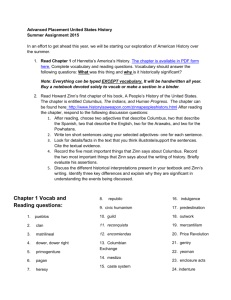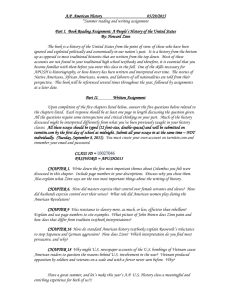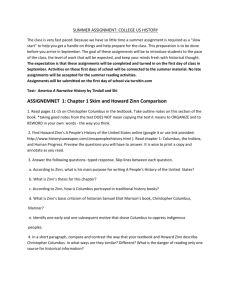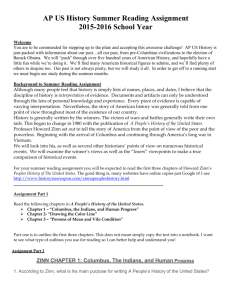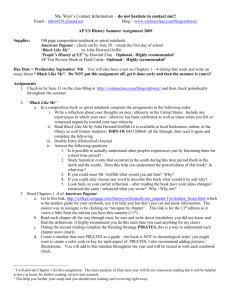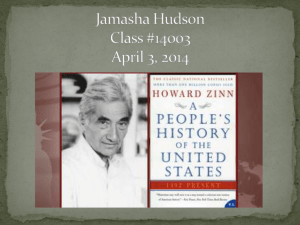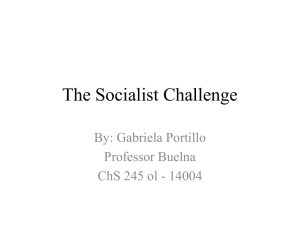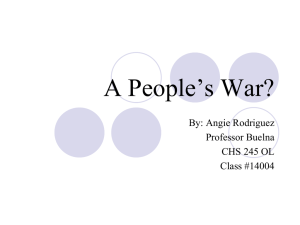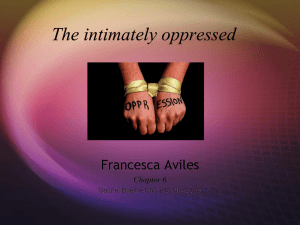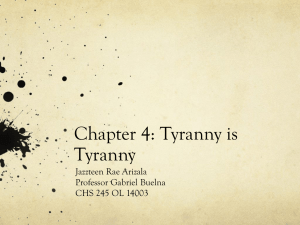Read Zinn, Chapter 1. Columbus, The Indians, and Human Progress
advertisement
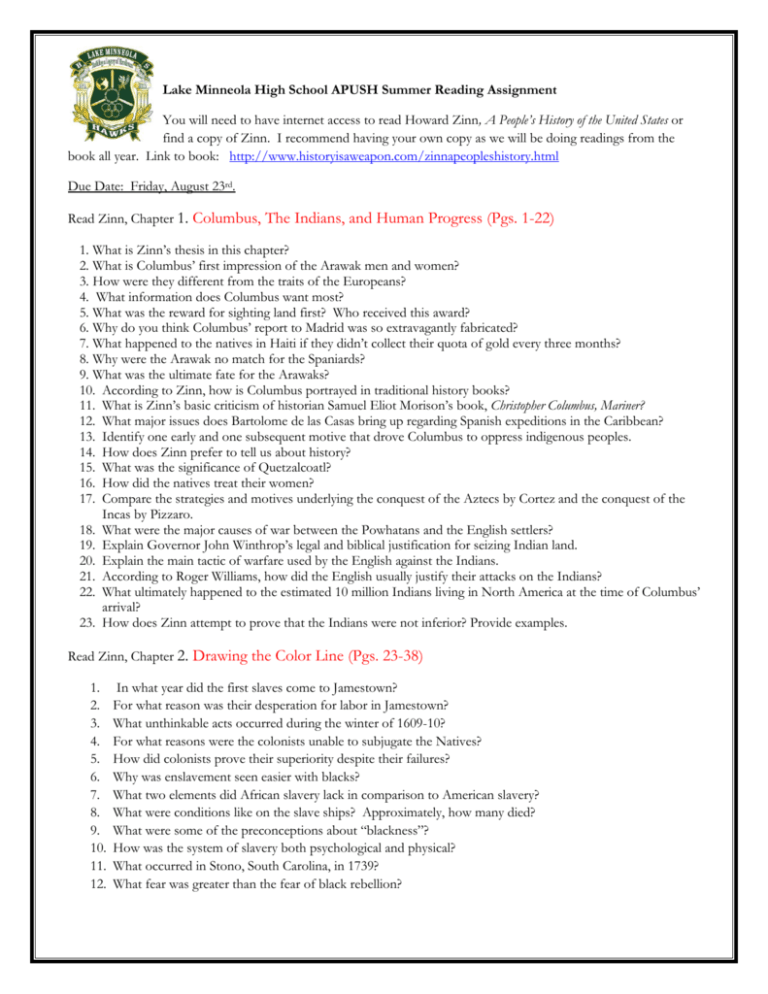
Lake Minneola High School APUSH Summer Reading Assignment You will need to have internet access to read Howard Zinn, A People’s History of the United States or find a copy of Zinn. I recommend having your own copy as we will be doing readings from the book all year. Link to book: http://www.historyisaweapon.com/zinnapeopleshistory.html Due Date: Friday, August 23rd. Read Zinn, Chapter 1. Columbus, The Indians, and Human Progress (Pgs. 1-22) 1. What is Zinn’s thesis in this chapter? 2. What is Columbus’ first impression of the Arawak men and women? 3. How were they different from the traits of the Europeans? 4. What information does Columbus want most? 5. What was the reward for sighting land first? Who received this award? 6. Why do you think Columbus’ report to Madrid was so extravagantly fabricated? 7. What happened to the natives in Haiti if they didn’t collect their quota of gold every three months? 8. Why were the Arawak no match for the Spaniards? 9. What was the ultimate fate for the Arawaks? 10. According to Zinn, how is Columbus portrayed in traditional history books? 11. What is Zinn’s basic criticism of historian Samuel Eliot Morison’s book, Christopher Columbus, Mariner? 12. What major issues does Bartolome de las Casas bring up regarding Spanish expeditions in the Caribbean? 13. Identify one early and one subsequent motive that drove Columbus to oppress indigenous peoples. 14. How does Zinn prefer to tell us about history? 15. What was the significance of Quetzalcoatl? 16. How did the natives treat their women? 17. Compare the strategies and motives underlying the conquest of the Aztecs by Cortez and the conquest of the Incas by Pizzaro. 18. What were the major causes of war between the Powhatans and the English settlers? 19. Explain Governor John Winthrop’s legal and biblical justification for seizing Indian land. 20. Explain the main tactic of warfare used by the English against the Indians. 21. According to Roger Williams, how did the English usually justify their attacks on the Indians? 22. What ultimately happened to the estimated 10 million Indians living in North America at the time of Columbus’ arrival? 23. How does Zinn attempt to prove that the Indians were not inferior? Provide examples. Read Zinn, Chapter 2. Drawing the Color Line (Pgs. 23-38) 1. 2. 3. 4. 5. 6. 7. 8. 9. 10. 11. 12. In what year did the first slaves come to Jamestown? For what reason was their desperation for labor in Jamestown? What unthinkable acts occurred during the winter of 1609-10? For what reasons were the colonists unable to subjugate the Natives? How did colonists prove their superiority despite their failures? Why was enslavement seen easier with blacks? What two elements did African slavery lack in comparison to American slavery? What were conditions like on the slave ships? Approximately, how many died? What were some of the preconceptions about “blackness”? How was the system of slavery both psychological and physical? What occurred in Stono, South Carolina, in 1739? What fear was greater than the fear of black rebellion? Read Zinn, Chapter 3. Persons of Mean and Vile Condition (Pgs. 39-58) 1. What is Zinn’s thesis in this chapter? 2. What was the underlying cause of Bacon’s Rebellion? 3. What was the "double motive" of the Virginia government with regard to Bacon’s Rebellion? 4. What groups of people took part in Bacon’s Rebellion? 5. Explain indentured servitude (also known as the "headright system"). 6. How did the voyage of indentured servants to America compare with the "Middle Passage." 7. What generally happened to indentured servants after they became free? 8. To what extent did a class structure emerge in America by 1700? 9. What evidence does Zinn provide regarding the monopoly of power by the rich in Boston? 10. Explain the statement: "The country therefore was not "born free" but born slave and free, servant and master, tenant and landlord, poor and rich." 11. How did the rich manage to keep Indians "at a distance?" 12. What was the probable reason why Parliament made transportation to the New World a legal punishment for crime? 13. Explain the statement: "race was becoming more and more practical." Read Zinn, Chapter 4. Tyranny is Tyranny (Pgs. 59-75) 1. What is the thesis of this chapter? 2. According to Zinn, how did the creation of the United States benefit the upper class? 3. Describe the disproportionate distribution of wealth in Boston, Philadelphia, and New York. 4. Why were both Loyalists and leaders of the Revolution concerned about the lower classes in Philadelphia? 5. What major issues fueled the Regulator movement? 6. What was General Gage’s observation regarding the leaders of the movement against the Stamp Act? 7. What advice did colonial leaders including -- Samuel Adams and James Otis -- give to the people concerning the Townshend Acts? 8. What class did the leaders of the Sons of Liberty come from? What was their goal? 9. What was the significance of Patrick Henry’s oratory? 10. What was one of John Adam’s concerns regarding Thomas Paine’s Common Sense? 11. According to Zinn, who does Paine really represent? 12. What groups of Americans were deprived of the ideals set forth in the Declaration of Independence? 13. What is the irony Zinn tries to convey concerning John Locke? 14. Explain the statement: "Tyranny is Tyranny let it come from whom it may." I want to give you advance notice that we will also be reading the novel, Killer Angels, by Michael Shaara the first nine weeks of school. It is a civil war novel about the Battle of Gettysburg. You may want to get a copy of the book over the summer and do some reading in advance. Watch some good historical movies this summer or documentaries, begin your strive for a five a bit earlier than everyone else. APUSH EXAM date is Wednesday, May 14th. Enjoy your summer with family and friends and come back in August ready to work hard. Looking forward to meeting you and an awesome school year! Go hawks! Please e-mail me if you have any questions, Ms. Jessica A. Goody goodyj@lake.k12.fl.us
